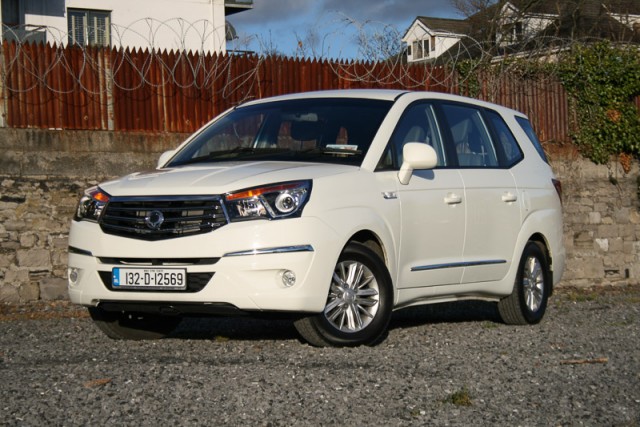Good: utterly massive inside, lots of standard equipment, not all that bad to drive
Not so good: gobsmacking-ly crude in places, overhangs most car park spaces, competition may be smaller but are most definitely still superior
Keeping the old parental adage of “if you can't say something nice then don't say nothing at all” in mind meant that writing a road test of the old SsangYong Rodius was something of an exercise in blank screens. Just how could you find something good to say about a massive and massively ugly people carrier that was awful to drive and depreciated at the speed of sound?
Equally, how then to write the report on the new one? Is being not terrible good enough? Certainly it's a massive improvement on the outgoing model, but then that would not have been difficult. Having no car at all would have been an improvement.
The first thing that one notices about the new Rodius is that it's not ugly. In fact, you could almost call it handsome [Neil may be on his own in this one dear reader - Ed], and there is a distinct whiff of Americana about it. Anyone who's had a Chevrolet Suburban fetish but has been unwilling to take the leap into left-hand drive should certainly have a Rodius at the top of their shopping list.
The second thing you notice is that it's massive. Utterly huge. And while we have seen cars in the past that are huge on the outside and tiny on the inside (yes, Mercedes-Benz GL, we're looking at you) the Rodius translates those gargantuan proportions from the outside to the in. So, while the Rodius' 5.1-metre length means you will struggle to parallel park it (even with the standard-fit parking sensors) there is a pay-off once you get inside. There are seven seats, laid out in a slightly odd 2+2+3 formation. All the rear seats slide and fold and if you want to maximise the boot space, you can take the third row out altogether. The middle seats lie flat to form beds, which could be useful if you want to pull into a scenic lay-by and spend the night, and even with all seven seats in place, the boot volume is an astonishing 875 litres in capacity. The Rodius, then, is the only car that can answer the question of how do I buy a seven-seater with proper luggage space?
Behind that bluff front styling is a 2.0-litre 155hp turbodiesel engine that gets about its work in a most acceptable fashion. It's certainly not quiet, and its constant mooing and growling was not helped by our test car's automatic gearbox wanting to hold on to lower gears for longer than seemed necessary, but it's a long way from being the worst of engines. Emissions of 199g/km seems hardly too clever though, and the 7.6 litres per 100km combined fuel consumption figure is entirely fictional - low nines will be your more likely average.
Climb aboard the SS Rodius and things are, well, a little bit odd. The driving position is astonishingly perched up and strange, pushing you up towards the roofline. Because of the flat-floor design, your legs have pretty much nowhere to go so you tend, if you're my height, to drive with your knees in your ears. The dashboard is an equally strange mix, with a huge central instrument binnacle, augmented by a tiny digital display for speed, revs and gear mounted on the steering column, which looks as if it came in a Christmas cracker. Likewise, the display for the rear parking sensors, which appears to have been mounted on the windscreen pillar with Blue-Tac. The cabin is just such an odd amalgam of surfaces and textures, from a steering wheel (and its multi-function buttons) that feels staggeringly nasty and cheap to other trim that actually look and feel quite nice.
To drive, it's surprisingly not bad. Oh, it wallows like a boat and will do nothing but understeer, and it's certainly not quick, but the Rodius actually plods along in a manner you could describe as OK. It doesn't fall over in corners and twisty roads, and while you have to take them a little slowly to allow for the long-winded steering, otherwise they present the Rodius with no particular problems. There is a problem with the ride quality though, which is just too firm and can't seem to soak up exactly the sort of small jiggles and sharp speed bumps that will surely make up most Rodius' school-run/airport-run lives.
For €36,995, the Rodius is just about unbeatable on a sheer Euro-per-square-footage measurement, but the €42k asked for our extra-toys LE automatic model is probably a bit steep for a car with this badge and this name. Still, there is simply nothing else out there for the money into which you can cram quite so many people and luggage. Once again, I would imagine, the primary customers for the Rodius will be taxi operators, especially those who pick up erstwhile Boeing and Airbus passengers on a regular basis. While they're not getting a car you could describe as particularly good, they are at least getting one you could call adequate, and that is a major improvement for a car carrying the Rodius name.
Alternatives:
Chrysler Grand Voyager: big and not great to drive, but very comfy and families and airport taxi firms love 'em.
Ford Galaxy: due for replacement soon but the biggest Ford is hugely spacious and exceptionally good to drive.
SEAT Alhambra: well-priced enough to make the Rodius blush; comes with clever sliding side doors and lots of space.















